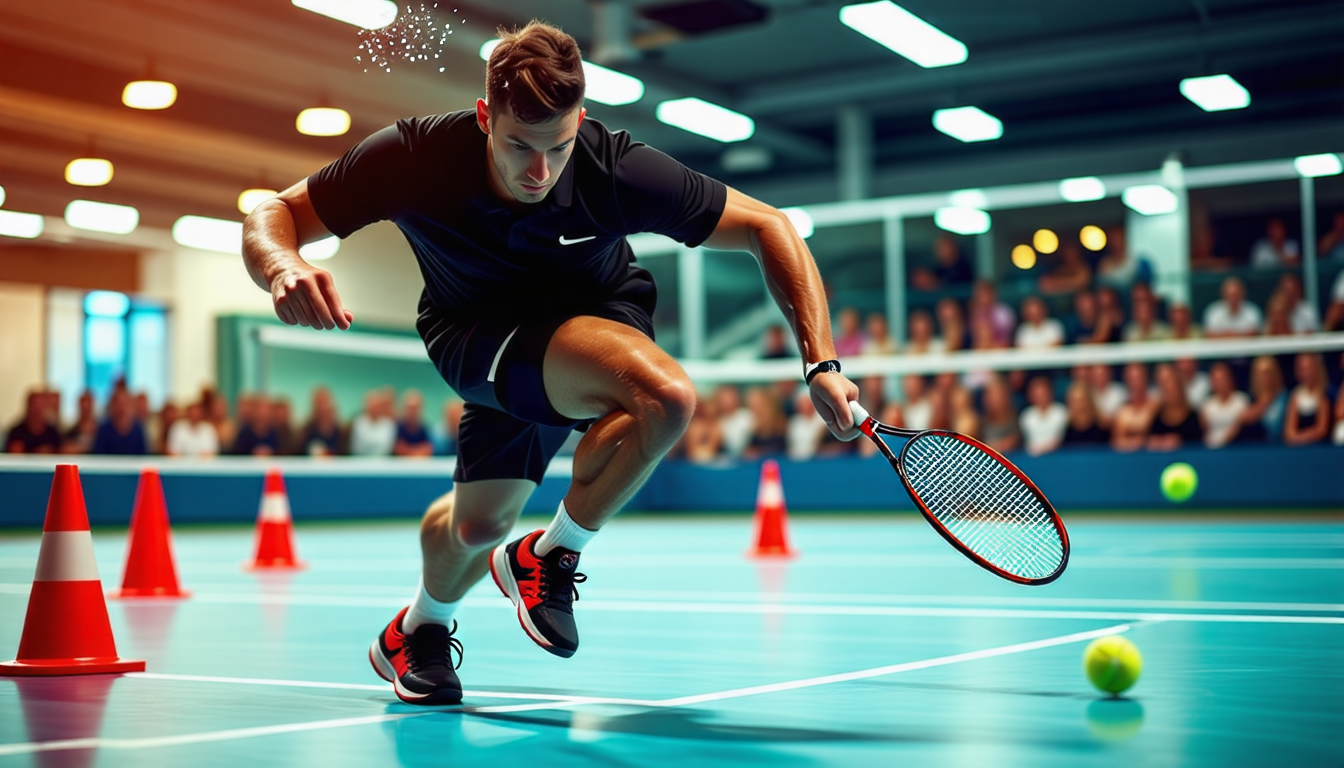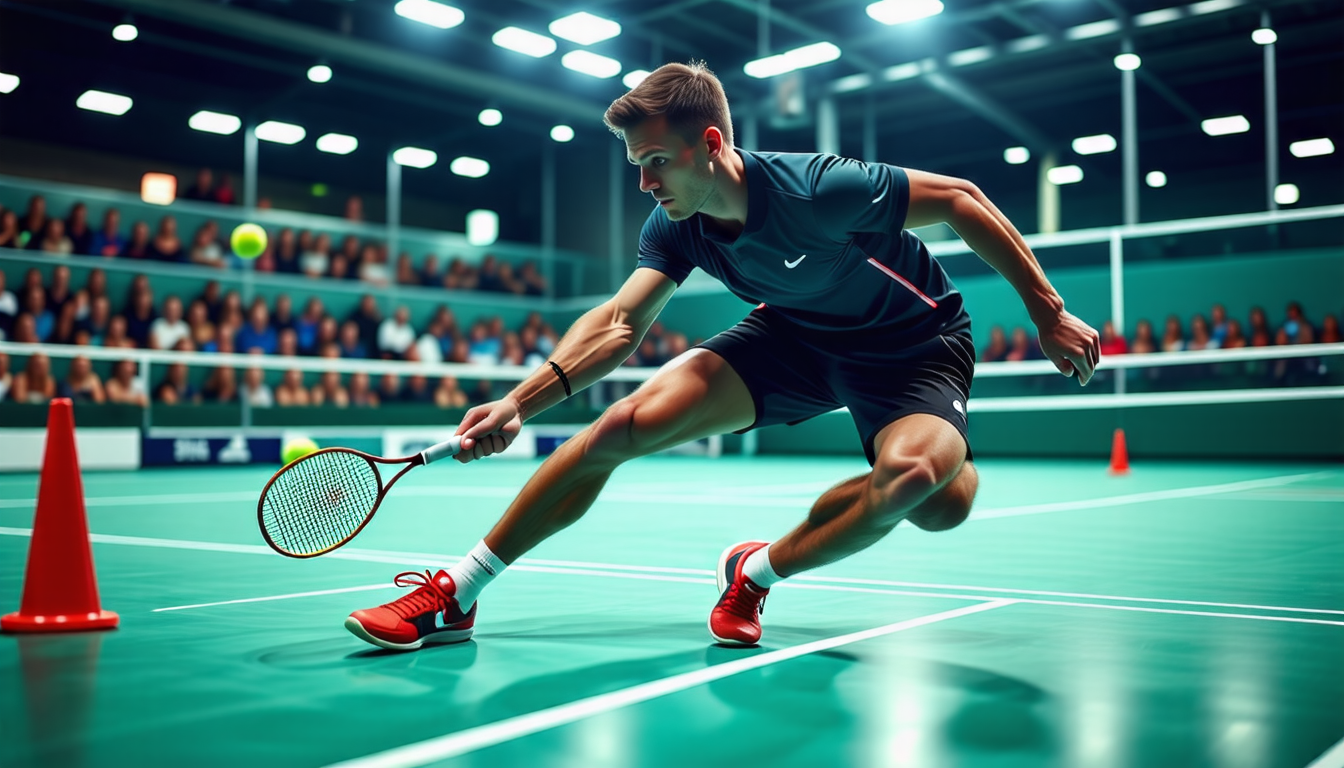|
IN BRIEF
|
In the fast-paced world of squash, footwork often distinguishes the champions from the mere competitors. The ability to move swiftly and efficiently across the court is crucial for not only reaching the ball but also for executing precise shots. As players, improving your footwork should be a primary focus, as it lays the foundation for enhanced performance. Whether you are a novice eager to develop your skills or an advanced player looking to refine your game, the right techniques can lead to significant improvements. Key elements such as your starting position, quick directional changes, and agility drills can transform how you navigate the court. Embracing these practices will not only elevate your overall game but also boost your confidence in every match.

Understanding the Importance of Footwork in Squash
Footwork is arguably one of the most critical components of a squash player’s overall performance. Its significance cannot be overstated, as it forms the foundation for effective movement throughout the court. Strong and efficient footwork allows players to reach the ball quickly, execute shots accurately, and maintain balance during rallies. By enhancing footwork, players can elevate their game to new heights.
Key Elements of Proper Squash Footwork
To truly understand how to improve your footwork, it is essential to break down the key elements that contribute to effective movement on the court. Three primary aspects should be your focus: stance, agility, and speed.
Stance
A proper stance sets the tone for all movements in squash. Players should adopt a position where their feet are slightly wider than shoulder-width apart, allowing for a quick shift in direction. Starting each movement with a small jump can enhance readiness, facilitating immediate responses to dynamic plays. This basic stance maximizes balance and prepares the body for fast lateral movements.
Agility
Agility plays a significant role in effective footwork. Squash requires rapid changes in direction, and being agile allows players to adapt seamlessly. Incorporating agility drills, such as side shuffles and quick feet exercises, can vastly improve one’s ability to change direction without losing momentum or stability. Additionally, practicing star drills can help reinforce step sequences from various court positions, further solidifying agility on the court.
Speed
Speed is undoubtedly an asset on the squash court. Enhanced foot speed can significantly cut down reaction times and allow players to anticipate their opponent’s moves. To develop speed, incorporate sprinting drills and hill runs into your training routine. Regularly practicing split steps is also crucial, as it activates the muscles required for explosive lateral movement when defending or attacking the ball.
Effective Drills to Enhance Footwork
Identifying effective drills can be key to developing better footwork. Here are various exercises tailored to improve different aspects of footwork, ensuring a holistic training experience.
Jump Lunges
Jump lunges are a fantastic way to engage the lower body muscles crucial for squash. This drill involves jumping from one lunge position to another, effectively mimicking the explosive movements required on the court. By incorporating jump lunges into your workout regimen, you enhance leg strength, coordination, and overall footwork accuracy. For instructional guidance, check out this video.
Ladder Drills
Ladder drills can help develop foot speed and coordination. Setting up an agility ladder allows for various footwork patterns, ranging from lateral shuffles to quick step-ins. These exercises not only build speed but also train your brain to process foot placements more effectively, essential for navigating complex movements during a match.
Shadow Squash
Practicing shadow squash can be incredibly beneficial in refining footwork. By mimicking squash movements without hitting the ball, players can concentrate solely on their foot placements and movements. During these drills, focus on maintaining balance and ensuring your feet are light and responsive, making adjustments as needed to simulate realistic court situations.
Practicing Footwork During Matches
It is crucial to implement footwork skills learned during training in match scenarios. Incorporating specific drills during practice matches can better translate skills developed in training to actual gameplay.
Working on the Split Step
The split step is a vital technique that every squash player should master. It serves as the catalyst for both offense and defense. Players should focus on mastering the timing of their split step to enhance their reaction speed. When anticipating your opponent’s shot, practice jumping just as they strike the ball to achieve optimal positioning. This tactic will enable quicker movement off the T and better shot execution.
Using T-Position Movements
Effective footwork revolves around the T-position, where players are centered on the court, ready to move in any direction. During practice sessions, incorporate movements that reinforce returning to the T after each shot. This habit plays a crucial role in maintaining optimal court positioning, allowing for efficient defense of shots from all angles.
Simulated Match Scenarios
Creating simulated match scenarios can help in mastering footwork under pressure. In practice, set up drills that replicate game-like conditions, enabling yourself to test footwork skills in a competitive context. This training can help in identifying gaps in your movement and adjusting accordingly.
Conditioning for Footwork Enhancement
Physical conditioning is imperative in supporting footwork development. By prioritizing flexibility, strength, and cardiovascular fitness, players can improve their overall performance on the squash court.
Strength Training
Strength training is essential to increase overall muscle capacity and endurance. Focus on leg workouts, particularly exercises targeting the quadriceps, hamstrings, and calves, as these muscle groups are heavily utilized in squash movements. Incorporate squats, deadlifts, and calf raises into your routine to generate power for explosive movements.
Flexibility Exercises
Flexibility is equally important as it allows for more extensive movement ranges on the court. Incorporating stretching routines or yoga can improve flexibility, resulting in smoother movements and enhanced footwork. Engaging in regular flexibility exercises can reduce stiffness, further lowering the risk of injuries during explosive court maneuvers.
Cardiovascular Fitness
A high level of cardiovascular fitness allows players to maintain stamina throughout matches, ensuring footwork does not falter from fatigue. Interval training, running, and cycling are excellent for boosting cardiovascular health. By building endurance, players are better equipped to sustain high levels of performance, enhancing their ability to execute footwork efficiently.
Injury Prevention Through Footwork Training
Injuries can significantly hinder a player’s performance and development. Therefore, focusing on injury prevention as part of footwork training is essential.
Strengthening Support Muscles
To protect against foot-related injuries, strengthening support muscles is vital. Incorporating exercises that target ankle stability and knee alignment can help prevent common injuries. Engage in balance exercises and proprioception training to ensure all muscles surrounding the joints are functioning harmoniously. Regular conditioning and strengthening routines will create a solid foundation for effective footwork.
Proper Footwear
Wearing appropriate footwear can also significantly influence footwork effectiveness and injury risk. Shoes designed specifically for squash provide the necessary support and grip on the court surface, facilitating quick movements and reducing slip hazards. When investing in shoes, prioritize comfort and ensure they fit correctly to encourage better footwork.
Monitoring Playing Surface
Pay attention to the playing surface, as it plays a crucial role in footwork effectiveness and injury prevention. Always inspect the court for any potential hazards or damage that may impede movement, and choose facilities that maintain a safe surface. Identifying risks in the environment can help in avoiding injuries while optimizing footwork training.
Utilizing Online Resources for Footwork Improvement
In today’s digital era, numerous resources are available online that offer valuable insights and training tips for enhancing footwork.
Video Tutorials and Drills
Watching video tutorials can provide guidance on footwork drills and techniques. Tutorials featuring professional players often highlight the nuances of footwork, offering new perspectives that can be challenging to grasp through text alone. A couple of useful videos include this one on footwork basics and this one focused on advanced drills.
Online Courses and Communities
Joining online squash communities can cater to personalized training experiences, allowing players to engage with others and share footwork techniques. Enrolling in online courses can provide structured training that tackles footwork improvement systematically, keeping players engaged and motivated.
Engaging with Professional Players
Following professional players through social media channels or dedicated platforms can shed light on training techniques, including footwork drills they employ. Players like Paul Coll often share essential practices that aspiring athletes can implement into their training. Apps and websites offer various insights around the best practices for improving footwork, serving as motivational tools to encourage better gameplay.

Footwork is a critical component of successful squash performance. Research indicates that players with superior footwork can gain as much as a 20% advantage in match performance. This is because agile movement allows players to access the ball more effectively, positioning themselves for optimum shots.
To improve your footwork, it’s essential to focus on specific drills designed to enhance speed and agility. For instance, implementing practices such as star drills can simulate game-like scenarios, training you to adapt your movements as you anticipate your opponent’s plays. These drills not only build strength but also increase your responsiveness, allowing quicker transitions around the court.
The importance of the split step cannot be overstated. This initial move acts as a launchpad for further action, enabling players to explode toward the ball with a balanced center of gravity. Additionally, integrating exercises like jump lunges can greatly improve the explosiveness required when navigating the court.
By incorporating structured training routines and focusing on essential elements of footwork, players can substantially elevate their overall squash capabilities. For more effective solutions, consider exploring resources available at SquashSkills or Howick Squash Club.

In enhancing your footwork for better squash performance, it’s essential to prioritize several key aspects. Begin by mastering the split step, which allows you to quickly react to your opponent’s shots. Incorporate drills into your training routine that simulate game scenarios, focusing on the proper sequencing of steps and maintaining balance. Furthermore, develop your agility and speed through targeted exercises, such as lateral shuffles and star drills, which improve your movement around the court. Remember that starting each movement with a slight jump and ensuring your stance is shoulder-width apart will provide a solid foundation for effective footwork. With consistent practice and dedication, your footwork will become a powerful asset in enhancing your overall squash game.
What is the importance of footwork in squash?
R: Footwork is crucial in squash as it directly affects your ability to reach the ball efficiently and maintain positional advantage on the court. Good footwork allows players to execute shots more effectively and react swiftly to their opponent’s movements.
How can I start improving my footwork?
R: Begin by focusing on the basics: practice a small jump to initiate movement. Ensure your feet are positioned slightly wider than shoulder-width apart. This stance provides a solid foundation and enhances balance, enabling quicker reactions and smoother transitions across the court.
What types of drills can help enhance squash footwork?
R: Engaging in drills that emphasize speed and agility can improve your footwork significantly. Exercises like “star drills” or variations of ladder drills help practice specific movement patterns while enhancing your coordination and overall movement efficiency on the court.
How can I utilize the split step effectively?
R: To maximize your movement potential, focus on your split step positioning. As your opponent prepares to hit the ball, perform a quick jump and land on the balls of your feet, ready to push off with the appropriate foot. This technique allows for immediate acceleration in any direction, improving your responsiveness.
Can strength training improve my footwork?
R: Absolutely! Strength training enhances your overall stability, power, and endurance, all of which are fundamental for effective footwork. Incorporating exercises that target leg strength, core stability, and agility will contribute to quicker and more controlled movements during matches.

